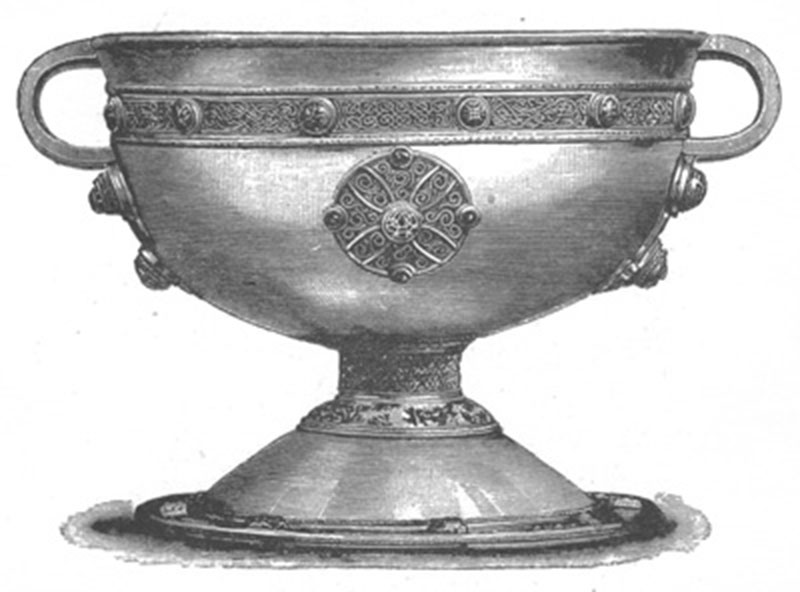Ardagh Chalice - Irish Pictures (1888)
From Irish Pictures Drawn with Pen and Pencil (1888) by Richard Lovett
Chapter 1: Ireland’s Eye … continued
« Previous Page | Start of Chapter | Book Contents | Next Page »
It would be possible to fill many pages with descriptions of the beautiful objects contained in this museum, illustrative of the knowledge, skill, and perseverance put forth at a time when many persons fancy that Ireland was inhabited only by hordes of savages, mainly occupied in the slaughter of each other. The museum is crowded with whole classes of specimens of which we can take no note—arms, dress, objects the uses of most of which are known, but in some few cases remain yet undiscovered, illustrative of all epochs of Irish history, and of all classes of people who, during historic and even prehistoric times, have lived upon Irish soil. In fact, the only museum that equals it in compactness, in devotion to very clearly defined objects, and in comfort to the observer—by which we mean skilful arrangement of contents, combined with the fact that these are not bewildering in number and extent—is the much more widely-known Museum of Northern Antiquities at Copenhagen. All readers of this book who wish to appreciate the past of Ireland should make a point, whenever they visit Dublin, of giving more than a hasty inspection to this treasure-house of the past. Much, however, as we should like to linger, we have space to glance at only three more typical specimens, viz., the Ardagh Chalice, the Tara Brooch, and the Cross of Cong.
The gem of the whole collection, and in many respects one of the most beautiful and noteworthy objects in Europe, is the Ardagh Chalice.
When it was made no evidence is extant to show, but all judges agree that at the very least it is over 1000 years old. It was found, with other specimens of Celtic art by a lad digging potatoes in a rath or early fort near the village of Ardagh in Co. Limerick. It belongs to the class of cups known as calices ministrales, in use before the tenth century, intended for the use of the minor clergy and laity, before the Roman Catholic Church debarred the laity from the communion in both kinds.
The chalice is composed of an alloy of silver, is seven inches high, nine and a half inches in diameter, the bowl being four inches deep. In the various parts, no less than 354 in number, gold, silver, bronze, brass, copper and lead, are used. The upper rim is of brass, much decayed and split from some local action on that particular kind of alloy. The bowl is of silver, the standard value of which is four shillings to the ounce. The ornaments cut on the silver bowl consist of an inscription, interlaced patterns terminating in dogs' heads, and at the bottom a circular band of the Greek pattern. The mode of ornamentation is peculiar to this cup, being done with a chisel and hammer. Round the cup runs a band composed of two semi-cylindrical rings of silver ornamented with small annular dots punched out with a hollow punch. The space between the rings is filled with twelve plaques of gold repoussé work with a very beautiful ornamentation of fine filigree wirework, wrought on the front of the repoussé ground, and carrying out in its most delicate execution the interlaced pattern associated with the art of the country. Between the plaques are twelve round enamelled beads.[11]
Although the object is so small, there are no less than forty different designs discoverable in its decorative work. A well-preserved inscription is engraved on the cup containing the names of the twelve apostles as given in the Romish Canon of the Mass.
NOTES
[11] Early Christian Art in Ireland, p. 81.
« Previous Page | Start of Chapter | Book Contents | Next Page »

